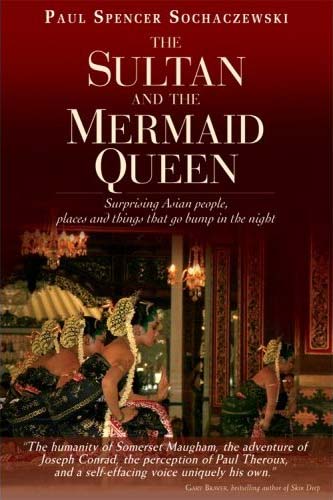
The Sultans of Yogyakarta and Solo, in Central Java, Indonesia, trace their ancestry, and their legitimacy, to a Mermaid Queen. To a kid born in Brooklyn and raised in New Jersey, this concept, this practice, this conundrum, is spectacularly tantalizing. Since I was a child I've been intrigued by distant pastures. It was armchair imagining, mostly, writing school reports about Tibet and reading The Wonderful Flight to the Mushroom Planet, the first book I ever read that had no pictures. Every day in Asia I realize that I will hear of an occurrence that I not only do not understand but in a dozen lifetimes would have no hope of comprehending. And each day I will find someone willing to explain what's going on, with more patience, probably, than I would explain the rules of baseball to a first-time visitor to America. I would not have learned of these people and situations without one of the 20th centuries most senseless and controversial periods -- the Vietnam War. Not to make it sound too romantic, or push the pun, but the summer of 1969, when I graduated from university, was a heady time. I had just one big, wouldn't go-away constraint, the Vietnam War. I earned a temporary reprieve by joining the Peace Corps. I asked for Botswana, deep in Africa and about as far from my middle class milieu as possible. The bureaucrats sent me to Borneo, more precisely to the Malaysian state of Sarawak, and my world changed. I was introduced to places whose names resonated with history and incense, glamour and promise. There's Sumatra, Java and Borneo; Malacca, Vientiane, and Makassar; Kelantan, Kathmandu and Ayudhya. Not to mention the rivers: Ganges and Yangtze, Mahakam and Mekong. Names rich with allure, and also ripe with the sense that they were somehow unobtainable, unknowable. The Call of the Maybe, the Cry of the What-If. Here is one of those stories.
Read an Excerpt from "The Sultan and the Mermaid Queen" by Malaysia RPCV Paul Sochaczewski
THE SULTAN AND THE MERMAID QUEEN
A love story for the ages
SOLO, Indonesia
The instructions, given by a friend of Javanese nobility, were tantalizingly vague. If you look really carefully, and if the wind is blowing right and you are of good heart and you let yourself "switch mode" into a semi-trance, you just might see a tenth dancer. That would be the Mermaid Queen herself.
My friend was referring to the bedoyo ketawang, a sacred court dance held once a year, in August, in honor of the on-going love affair between the sultans of Java and Kanjeng Ratu Kidul, a mermaid-like spirit who is considered the Queen of the Southern Ocean. In this 90-minute performance nine virgins weave an intricate and highly stylized ritual in front of the current Sultan of Solo, Susuhunan Paku Buwono XIII. If a tenth dancer is seen, palace-watchers say, that blink-of-an-eye appearance would be the Mermaid Queen herself, come to pay her respects and reaffirm her love for the monarch.
Through my friend's intercession, my wife and I were invited to witness this dance, which is not open to the public. We thought it would be a perfectly suitable honeymoon event, more memorable than the Elvis impersonators of Las Vegas, more romantic than the fetid canals of Venice.
The bedoyo ketawang reflects one of Asia's most magical histoires d'amour -- the affair between Panembahan Senopati, a late 16th century king of Java, and Kanjeng Ratu Kidul, a princess who was turned into a mermaid goddess. Together, this unlikely couple began one of the world's longest-surviving regal lines -- the royal families of Yogyakarta and Surakarta, in central Java, Indonesia.
I have been intrigued by this fairy tale romance since I first came to Asia in 1969.
* * * * *
In one of many versions of the myth, a beautiful Javanese princess was afflicted by leprosy as a result of a curse inflicted by her jealous step-mother. In despair, the unfortunate young woman went to Java's raging southern coast to meditate, where a divine voice enticed her to enter the ocean and become reborn as a beautiful aquatic queen.
Meanwhile, Senopati, a very real Javanese ruler, was having his own crise de coeur and he too headed south for prayer and contemplation. While sitting on a rock on the precipitous sea cliffs south of Yogyakarta, Senopati was lured into the ocean by the spirit who became known as Kanjeng Ratu Kidul, the Queen of the Southern Ocean. During their three-day bacchanal in her submerged palace, she taught him the secrets of love and the intricacies of good governance.
As proof of her devotion, Kanjeng Ratu Kidul promised to be the consort for all of Senopati's descendants, a tradition which is still very much recognized.
The most direct lineage to Ratu Kidul is claimed by the Susuhunan of the Kraton Surakarta Hadiningkrat, more common referred to as the Susuhunan of Solo [the commonly used designation for this quiet town of 500,000, formally called Surakarta] , an hour's flight east of Indonesia's capital Jakarta.
* * * * *
In the mid-1980s I had interviewed the head of another, arguably more prestigious and important, Javanese royal family, about his relationship with Kanjeng Ratu Kidul. The late Sri Sultan Hamengku Buwono IX of Yogyakarta was a key figure in modern Indonesia's history since he played a vital diplomatic role during the Japanese occupation in WWII and helped to lead the fight for independence from the Dutch.
His love story with Kanjeng Ratu Kidul took place every June 21, when the sultan trekked 20 kilometers to the dangerous surf on the slate-gray southern coast of Java. There he offered a full set of women's clothing and his own nail and hair clippings to pay homage.
In 1984 I was granted an audience and, in his souvenir-filled Jakarta office had one question I wanted to ask him. I tried to phrase it in a refined Javanese manner. How was it that a man as pragmatic and cosmopolitan as the Sultan -- he had been vice president of Indonesia and had also held various ministerial posts -- could pay homage every year to a mermaid queen?
Instead of answering directly, Sri Sultan Hamengku Buwono IX, offered me sweet tea and told a story. "One night during the Dutch occupation of Yogyakarta, I, and others as well who were living in the kraton [palace], heard soldiers moving noisily about, as if wearing armour. It is said they were the soldiers of Ratu Kidul protecting the kraton." I pressed him for details. "There was no one in the kraton except our family and staff," he said matter of factly. "But we all heard the soldiers' drums."
I was more than a little sceptical at this, and several other tales he told, of Kanjeng Ratu Kidul's timely interventions that changed the course of Indonesia's history. The Sultan didn't quote Shakespeare, but he might as well have. He gave me the Javanese equivalent of "There are more things in heaven and earth, Horatio/ Than are dreamt of in your philosophy". He concluded: "When I was four years old I was already living with a Dutch family, so my brain is in some ways a western brain. But many things happen which can't be explained in a logical way."
I must have looked bewildered.
The Sultan then told me not to get too caught up in a Cartesian view of the world. "You're asking a Western question, expecting a Western answer," he admonished. "You either accept it or you don't."
There is much magic in the air throughout Java. Accept it or not. One man's myth-enrobed fantasy is another man's hard-nosed reality. In the rainbow-hued world of shifting Javanese cosmology, reality can be as ethereal as a wisp; like religion, like a miracle, like love, you believe it. Or not.
* * * * *
Visitors to Java might like to spend a night at the Samudra Beach Hotel at Pelabuhan Ratu (literally "Queen's Harbor") on the south coast of Java, scene of a dramatic appearance of the Mermaid Queen.
The story, as told to me by K.R.T. Hardjonagoro, the regent of the Susuhunan's palace in Solo:
"In 1966 Sri Sultan Hamengku Buwono IX [of Yogyakarta] attended the opening of the Samudra Beach Hotel, on Java's southern coast, which of course is Ratu Kidul's home territory," Hardjonagoro told me one evening as we nibbled some of the fried chicken for which Central Java is justly famous.
"In the morning, a few hours before the event, a local lurah [village headman] asked for an audience with the Sultan. The old man told the Sultan that he had had a dream the previous night in which a lady said she wanted her offerings. She was dressed in green.
"The Sultan, of course, knew that the old man had seen Ratu Kidul. His Highness thanked the humbled old man but explained that he would not make an offering since he was attending the hotel opening in his civilian capacity as Minister of Defence, and he wanted to separate the affairs of the state from the mystical duties of the palace." We ordered more chicken and Hardjonagoro continued. "I was outside, near the pool, when the Sultan said goodbye to the well-meaning old man. Shortly after I heard the sound of a locomotive. The noise increased until it sounded like ten locomotives were coming towards the beach-front terrace where we were enjoying the hotel's hospitality. Then a ten-meter high tidal wave erupted from the sea, which had been calm. It washed away the hotel's buffet table and soaked all the visitors. Some trees were knocked down. Someone ran to tell the Sultan what had happened, and realizing what had occurred, the Sultan put on his ceremonial clothes, said his prayers to Ratu Kidul and made the appropriate offerings. The sea was calm once again."
I was incredulous. Hardjonagoro showed me the photos. I said "come on," or something equally un-Javanese. Instead of arguing, he simply told me to go to the hotel and ask for Room 319. Sometime later, I did. This, it turns out, is the room in which Sultan Hamengku Buwono IX made peace with the easily irritated Mermaid Queen. It is kept locked and reserved only for her. For a tip, hotel staff will allow people access to so they can pray to the Queen of the Southern Ocean. It is a good business.
* * * * *
The bedoyo ketawang was originally performed as a six-hour marathon, all the better to put the dancers and audience into a trance-like state. Today, the occasional ringing of guests' cell phones reminds us that we live in a faster world, and the dance has been shortened to 90 minutes. Nevertheless, the atmosphere is reminiscent of a gaudy, precious but down-at-the-heels 19th century operetta, but also other-worldly, with spirits in the air, as the special gamelan orchestra pings and glongs a deliberate beat that accompanies a high-pitched singer. According to Nancy K. Florida of the University of Michigan, the verses first recount Senopati's setting forth to battle (or to a romantic encounter), then evoke the depth of Kanjeng Ratu Kidul's passion for Senopati and his royal successors, and end with her praise of the metaphysical potency of her lovers.
In the wrong frame of mind the bedoyo ketawang is as tedious as an Andy Warhol movie, but when I remembered my friend's advice to "switch mode" it became a hundred times more entrancing and a thousand times more elegant. Just as western Baroque music has been shown to induce relaxation (and learning) by reducing a person's heart rate and decreasing blood pressure, I have the impression that the bedoyo ketawang music, played on sacred gongs and xylophones used only on this occasion, alters our consciousness. Let's call it a Ratu Kidul-enhanced altered state.
The problem is that although we were seated near the front of what might be called the "commoner's section", we had lousy sightlines and had to crane our necks to see past two-meter tall statues of Greek goddesses and semi-clothed angels, huge Chinese vases, potted ferns, wrought iron rococo balustrades and a handful of photographers.
Nevertheless, we saw nine young women wearing sacred dark blue and white batik sarongs, colors which symbolize earth and ocean, light and darkness. They wore hair extensions pulled back in chignons entwined with golden filigree and jasmine garlands. They had been rehearsing for weeks, and were forbidden to dance if they were menstruating.
During the reception that followed the dance a man named Ki Radu Kusumodiningrat approached me and asked if I wanted to "speak with Kanjeng Ratu Kidul". I wasn't too sure what he meant but said yes anyway.
Ki Radu Kusumodiningrat, a relative of the Susuhunan, is a traditional healer. His colleague, the purported medium, Raden Ayu Retno Handayati, who was going to channel the Mermaid Queen, was also a distant relative; she works as an acupuncturist and massage therapist. We stopped at a market to buy fruit, candles and incense, and went back to our hotel for the sťance. The doorman busted us for the pungent-smelling durian, and out of respect for the no-smoking signs in the room we cancelled the incense, but the medium, Raden Ayu Retno Handayati, wasn't perturbed. She put on her veil and intoned an Arabic blessing. When her voice shifted to the timbre of that of a young woman and she asked our names we suspended belief and imagined we were speaking with the Mermaid Queen herself.
We asked her about her love affair with Senopati, and got romantic platitudes, sort of Javanese Hallmark card sentiments.
"Were you present just now at the bedoyo ketawang?"
Raden Ayu Retno Handayati, perhaps channeling Kanjeng Ratu Kidul, smiled and answered enigmatically "I'm always present for the Sultan."
We saw she was getting tired, but just before the channeling ended the MermaidQueen offered me personal support and invited me on a date, Javanese Mermaid-Queen-style. "Just go to the southern coast [of Java], call your name, stamp your foot three times and I will be there for you."
I'm not sure what to make of this. Did Raden Ayu Retno Handayati really channel the spirit of the Mermaid Queen? And what kind of reception will I get if I actually go to the beach and seek out Kanjeng Ratu Kidul? Stories are rife about men who wear green (Kanjeng Ratu Kidul's favorite color) while swimming in the Southern Ocean and who are never seen again - perhaps victims of the treacherous rip tides, perhaps whisked away to her watery castle.
I am intrigued by the possibility that Kanjeng Ratu Kidul was present at the dance, and put the question to one of the bedoyo ketawang dancers. Wuri, 23, is a soft-spoken English teacher at a local elementary school in Solo. She didn't find the question strange. "Yes, I had a feeling Ratu Kidul was there. One time I made a mistake in my movement and I felt her correcting me."
Another dancer, Putri, 21, acknowledged that towards the end of the performance she felt a current of air, as if Kanjeng Ratu Kidul was "going to the Sultan".
The morning after the bedoyo ketawang, we ran into one of the Susuhunan's close relatives, who was staying at the same hotel as us. Over croissants we asked the elegantly-dressed woman about the previous day's performance and whether she thought that Kanjeng Ratu Kidul had appeared.
"Absolutely," she said. Her eyes started to get misty and a dreamy look, wonderful to see in a woman of a certain age, came over her face. "There was a rush of cool air. That was the Queen, going to the King."
Again, I tried to ask a Cartesian question in a polite way. What did she make of all this?
In a wistful voice perhaps more suited to a lovestruck school girl she answered "It's a love affair for the ages."











